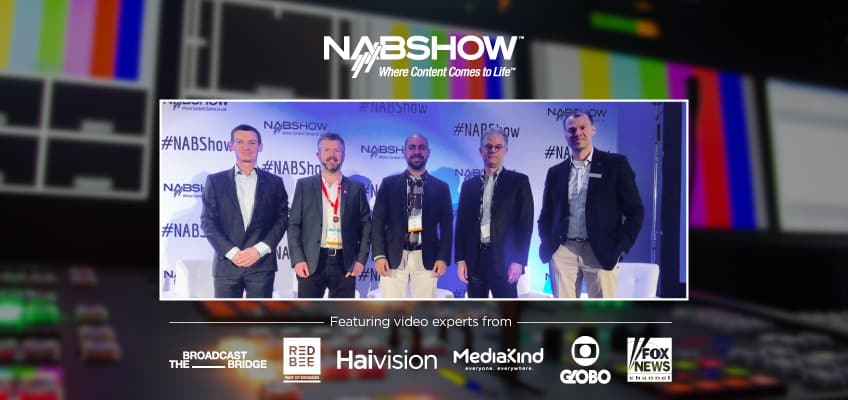We’re back with another post about SRT Trailblazers at this year’s NAB Show. This time, it’s the turn of broadcasters MediaKind, Red Bee Media, Globo TV and Fox News Channel who generously shared their experiences of using SRT during this panel discussion. Read on for an overview of their current uses cases and for further insight into the benefits that SRT is bringing to their contribution and distribution workflows. To watch the panel in full, check out the recording here.
SRT Offers MediaKind Protection and Low End-to-End Latency
Tony Jones, Principal Technologist at MediaKind kicks off the session with an explanation of how MediaKind is currently using SRT in their broadcast program distribution from broadcast networks to affiliates. A process which has traditionally been done using satellite, however, the ongoing costs of C-Band satellites, the pressure from mobile operators to get that spectrum back, coupled with reducing costs for IP distribution and the arrival of cloud technology have sparked a catalyst for change. MediaKind has created a wide area network-based distributed cloud, leveraging SRT as a protection mechanism for getting from the central headend for each targeted stream to its appropriate affiliate. Tony highlights that one of the benefits that SRT offers is its deterministic end-to-end latency, allowing MediaKind to ensure that stations all receive the content at exactly the same time, a critical broadcast requirement.
“SRT is extremely easy to use…it just works.” Tony Jones, Principal Technologist, MediaKind
Red Bee Media Extends its Reach with SRT
SRT is enabling Red Bee Media to expand its reach as a managed broadcast service provider by driving down costs so it can extend its services to a lower point in the market and widen the breadth of their reach. For a given budget or amount of bandwidth, they can bring in more signals to provide services for a wide range of content from music festivals, sports events as well as traditional linear and broadcast TV experiences. Red Bee Media’s services rely on connectivity to bring video into its studios which traditionally uses broadcast links based on satellite or fiber-based connectivity. Steve Russell, Head of Media Management and OTT, explains that as companies are looking to go direct to consumers with their video, the ability to use an internet connection – using SRT as a video transport protocol to overcome connectivity challenges – is an extremely powerful proposition.
The First to the Screen Wins: How SRT is Changing the Game
Steve was also excited to share how SRT is instrumental in significantly reducing end-to-end latency in OTT which, for live sporting events, for example, can really kill the viewing experience. Leveraging SRT as a contribution protocol over the open internet at the NAB Show, Red Bee Media managed to reduce end-to-end latency from 7 to 3.5 seconds. Incredibly, the video was delivered faster to a device than it would be to a TV screen. You can read more about this here.
“Using open standards, we’re achieving really high performance levels. I think it’s game changing.” Steve Russell, Head of Media Management and OTT, Red Bee Media.
Driving Down the Cost of OTT Contribution
\At the end of last year, TV Globo, a large media group headquartered in Rio de Janeiro, shifted its European operations, which feeds 12 headend facilities across Europe, from satellite to the internet. By leveraging SRT, TV Globo has been able to significantly drive down costs while maintaining quality. With an additional six operations that span across the globe along with contribution to its affiliates in Brazil, TV Globo is looking to expand its deployment of SRT in the future in order to create further cost savings.
“SRT gives us a very robust solution.” Leonardo Chaves, Transmission Technology Manager, TV Globo
SRT is an Integral Part of Fox News Channel’s Workflow
Robert Galker, Vice President, Satellite Operations, explains that Fox News Channel has been using Haivision’s nStream Mobile app to deliver SRT streams to multiple devices in the field. It has become an integral part of their workflow and they use it to deliver low latency, high quality video to mobile devices in the field for several applications such as teleprompters, return video and any content that needs to be viewed in the field using low latency. Robert takes a deeper dive through their workflows for both broadcast and mobile devices and explains how Fox News Channel is now actively working on control and monitoring access to their networks as well as effectively managing their bandwidth utilization.
“SRT has become an integral part of everything we do in the field. It’s a critical backup to satellite and fiber and it’s made a significant difference to the way we operate.” Robert Galker, Vice President, Satellite Operations, Fox News Channel
SRT Instrumental in Fox News Coverage of Hanoi Summit
Proving once again that SRT offers a flexible solution for complex situations, Haivision’s VP of Product Management, Ghislain Collette, walks us through step by step how the combination of SRT, Haivision’s Media Gateway and the Microsoft Azure backbone were used to deliver high quality, low bitrate video from the recent Hanoi Summit in Vietnam to Fox News headquarters in New York. Ghislain speaks to some of the challenges presented by transporting content over long distances over the open internet and explains how using a media gateway in a data center, Fox News was able to secure a better quality of bandwidth, leverage the backbone of the cloud and achieve the bitrate and quality level set for the production of the Summit.
What’s Next for SRT?
Ghislain explains how Haivision’s newly announced SRTHub has been designed to streamline the process of building live and file-based content workflows and eliminate much of the manual intervention required. Leveraging the power of SRT and the Microsoft Azure backbone, SRTHub will make it simple and fast for broadcasters to automate transport of live video and files for contribution, production and distribution workflows.
Want to learn more about how you can harness the potential of SRT in your broadcast workflows? Watch the full recording of the panel session here.


























